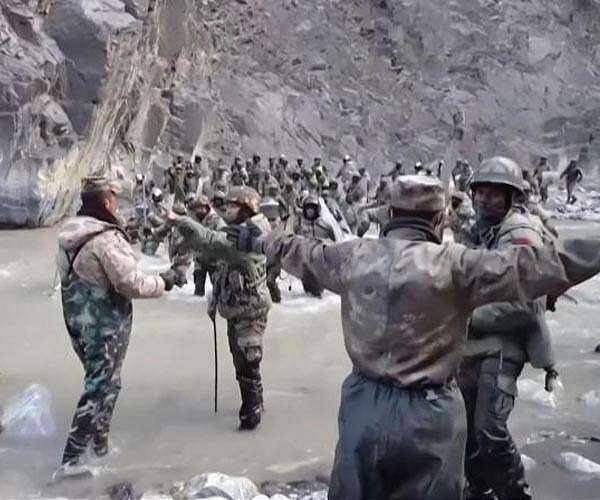(chathamhouse, june02)
Imagery of the disputed Aksai Chin territory reveals new Chinese military infrastructure and an increased strategic threat to India
India is facing continuing instability in a Himalayan flashpoint. The region of Aksai Chin has long been contested by India and China and was the site of deadly clashes between the two Asian powers three years ago.
Satellite images taken in the six months from October 2022 show a region increasingly in flux. Where once there were scattered People’s Liberation Army (PLA) checkpoints and rudimentary positions on the Chinese side of the poorly demarcated Line of Actual Control, now there is an established Chinese presence.
It is here that China has built an extensive set of installations, establishing an ecosystem to support its deployments of PLA troops. The images show expanded roads, outposts and modern weatherproof camps equipped with parking areas, solar panels and even helipads.
Claimed by New Delhi as part of Ladakh but administered by Beijing as part of Xinjiang and Tibet, Aksai Chin is home to the Galwan Valley, where 20 Indian soldiers and at least four Chinese soldiers died in a clash in June 2020. As both sides still disagree about the border’s precise location, the danger of an accidental clash escalating into a Sino-Indian crisis between the two nuclear powers is very much present.
For India, this means its armed forces will now have to match a large-scale and probably semi-permanent Chinese presence along the border with Aksai Chin, perhaps for years to come.
A desolate, uninhabited region
A desolate, uninhabited region with frozen peaks and icy lakes, as recently as 2019 Aksai Chin was relatively stable although tense. Meetings between Narendra Modi, the Indian prime minister, and Chinese President Xi Jinping had sought to manage tensions in the Himalayas after a standoff between the two countries in Bhutan in 2017. But all that changed in May 2020 when a number of PLA units made a large-scale incursion into the disputed territory of Aksai Chin, or Eastern Ladakh as India calls it.
Where previously Indian and Chinese foot patrols would meet, exchange words and eventually withdraw, that spring the PLA entered Aksai Chin in force. By the time the Indian Army responded, the PLA had established temporary positions at key sites. It was speculated in the Indian media that vital intelligence had failed to reach local Indian commanders, while those in senior positions allegedly underestimated the intentions of the PLA.
It was only through lengthy negotiations by Chinese and Indian commissioned officers and careful bilateral diplomacy at the foreign minister level that the crisis was prevented from escalating. In the Galwan Valley, a number of PLA bases connected by roads can now be seen leading up from the main standoff site, following the path of the frozen river.
In Raki Nala, a river valley south of the contested Depsang Plains, Chinese outposts are visible, potentially able to block Indian patrols in the area. Meanwhile at Pangong Tso, a saline lake surrounded by jagged peaks and unforgiving ridgelines, a bridge is nearing completion. When finished, it will allow the rapid deployment of Chinese forces from the PLA’s Rutog military garrison to the contested mountain ridges overlooking the lake.
India’s response to the PLA expanded presence has been multifaceted. On the ground, the Indian Army has sought to reciprocate China’s moves. India’s Northern Command has deployed blocking forces that match the Chinese activity and will prevent any further incursion. The Indian Army has also occupied the peaks of several mountains resulting in Chinese withdrawals from sensitive locations, notably around Pangong Tso.
These moves are matched by a sustained diplomatic effort. New Delhi’s priority is to avoid an outright military confrontation with China. Despite the bellicosity of nationalist voices, India’s leadership quietly recognizes the significant challenge Beijing and its modernized armed forces represent.
Wary of being drawn into a military clash, Modi has approached the militarization of Aksai Chin with caution. Guarded statements from his office have been accompanied by the Indian Army favouring lengthy border negotiations, the 18th round of which concluded in April this year.
Hotly debated
The reasons behind China’s sudden move across the Line of Actual Control are still hotly debated. Given the opaque nature of Chinese policymaking under Xi, the true motives are probably only known in the highest echelons. Whatever drove the decision, the PLA is now firmly ensconced in Aksai Chin and looks set to remain there.
Within the region, two areas of Chinese activity are notable that may yet ensure that tensions continue to simmer.
At the Depsang Plains, there continues to be significant Chinese activity. Patrols seemingly intend to put pressure on, and impede the development of, a strategic Indian airstrip at Daulat Beg Oldi, which serves as a logistics and transport base for Indian operations at high altitudes and is the highest airstrip in the world. It crucially supports Indian units arranged not just against China but also against Pakistan.
The second development relates to the proposed Chinese G695 highway intended to link Xinjiang with Tibet. It is due to be completed in 2035 and will run the length of Aksai Chin through the Depsang Plains, south past Galwan Valley and towards Pangong Tso. It represents a strategic artery that will connect the contested region to mainland China and give the PLA a new supply route. The road could also be read as a statement of intent from Beijing to New Delhi, signalling that Aksai Chin will remain a part of China. /end







